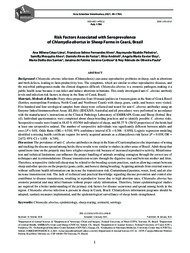Risk factors associated with seroprevalence of Chlamydia abortus in sheep farms in Ceará, Brazil.
Risk factors associated with seroprevalence of Chlamydia abortus in sheep farms in Ceará, Brazil.
Author(s): LIMA, A. M. C.; ALVES, F. S. F.; PINHEIRO, R. R.; ALVES, S. M.; FARIAS, D. A. de; ANDRIOLI, A.; ELOY, A. M. X.; SANTOS, M. D. dos; CARDOSO, J. de F. S.; PAULA, N. R. de O.
Summary: Background: Chlamydia abortus infections (Chlamydiosis) can cause reproductive problems in sheep, such as abortions and birth defects, leading to farm productivity loss. The symptoms, which are similar to other reproductive diseases, and the microbial pathogenesis make the clinical diagnosis difficult. Chlamydia abortus is a zoonotic pathogen, making it a public health issue because it can infect and induce abortions in humans. This study investigated anti-C. abortus antibody levels and infection risk factors in sheep in the State of Ceará, Brazil. Materials, Methods & Results: Forty-three properties from 10 municipalities in 4 mesoregions in the State of Ceará, Brazil (Sertões, metropolitan Fortaleza, North Ceará and Northwest Ceará) with sheep, goats, cattle, and horses were visited. Five hundred and four serological samples from sheep were collected and tested for anti-C. abortus antibodies using an Enzyme-linked Immunosorbent Assay (ELISA) [IDEXX®, Australia] and all procedures were performed in accordance with the manufacturer's instructions at the Clinical Pathology Laboratory of EMBRAPA Goats and Sheep (Sobral, Brazil). Individual questionnaires were completed about sheep breeding practices and to identify possible C. abortus risks. Seropositive results were found in 18.45 % (93/504 individuals) of sheep, and 88.37 % (38/43 properties) of the herds had at least one seropositive animal. The number of seropositive individuals was significantly different between adults and ewes [P < 0.01; Odds Ratio (OR) = 0.510; 95% confidence interval (CI) = 0.306 - 0.850]. Logistic regression modeling identified a missing health certificate request for newly acquired animals as a chlamydiosis risk factor [P = 0.038; OR = 2.672; 95% CI = 1.058 - 6.749]. Discussion: The prevalence of anti-C. abortus antibodies in sheep in the State of Ceara emphasizes the importance of testing and tracking the disease spread among herds; these results were similar to studies in other areas of Brazil. Adult sheep that spend more time on the property may have a higher exposure risk because of increased reproductive activity. Misinformation and technical limitations can influence the proper handling of animals avoiding contagion through the correct use of techniques and recommendations. Disease transmission occurs through the digestive tract and between mother and fetus. Therefore, seropositive (infected) sheep may be related to the breeding system practices, such as allowing contact between sheep and other species on the property (goats, cattle, and horses) during breeding. Acquiring animals from external sources without sufficient health information can increase the transmission risk. Contaminated pastures, water, food, and air also increase transmission risk. The lack of technical and practical knowledge regarding disease prevention and control also contributes to disease transmission, resulting in reproductive losses due to high abortion rates. Chlamydia abortus has zoonotic potential and may infect humans without proper safety information. Therefore, future epidemiological studies are required for a better understanding of the primary risk factors for disease occurrence and spread among herds in the region. Chlamydia abortus infection is present in sheep in Ceará, Brazil. Chlamydiosis information programs should be adopted, sanitary measures implemented, and the epidemiological surveillance of sheep herds strengthened.
Publication year: 2021
Types of publication: Journal article
Unit: Embrapa Goats & Sheep
Observation
Some of Embrapa's publications are published as ePub files. To read them, use or download one of the following free software options to your computer or mobile device. Android: Google Play Books; IOS: iBooks; Windows and Linux: Calibre.
Access other publications
Access the Agricultural Research Database (BDPA) to consult Embrapa's full library collection and records.
Visit Embrapa Bookstore to purchase books and other publications sold by Embrapa.

